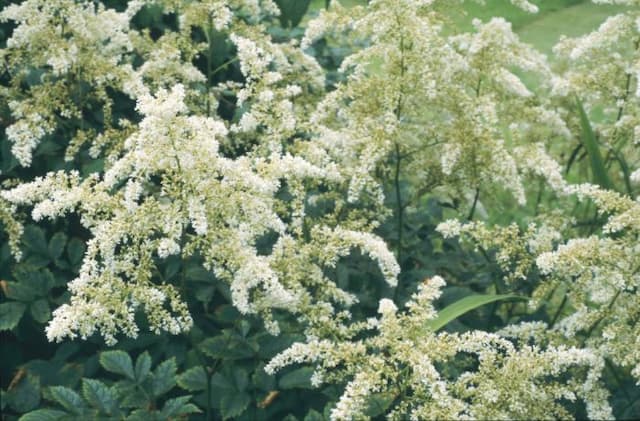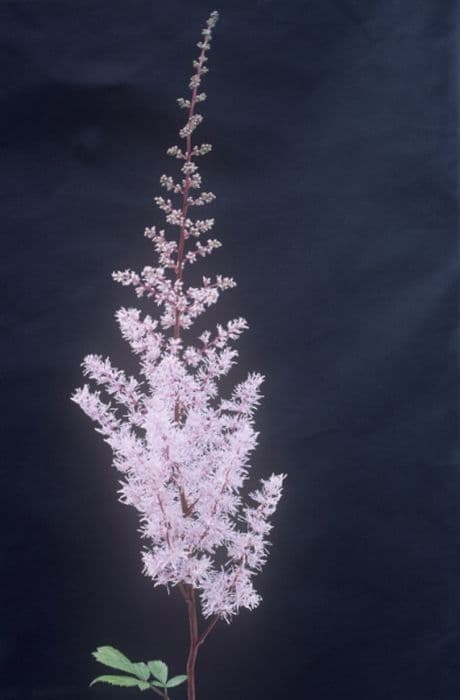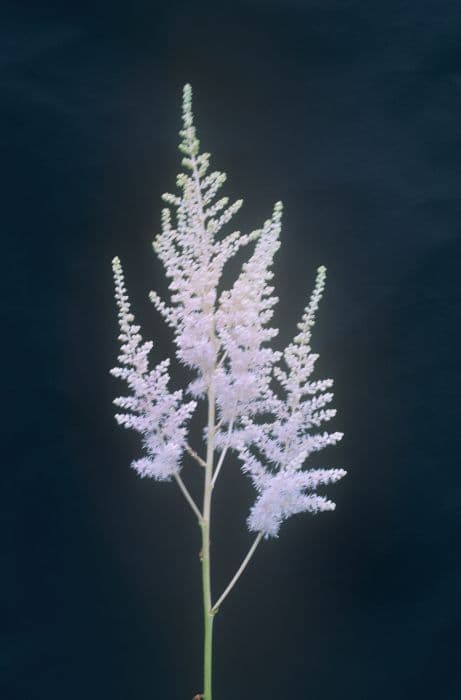Fortune's Saxifrage Saxifraga 'Shiranami' (fortunei) (5)

ABOUT
Saxifraga 'Shiranami' is an eye-catching perennial known for its attractive foliage and blooms. It forms a lush cushion composed of small, rounded leaves that are often bright green in color, providing a dense rosette-like effect. The leaves may have a slightly scalloped or serrated edge, adding texture to the plant's appearance. In the flowering season, it sends up delicate flower stalks that bear clusters of small, star-shaped flowers. These blossoms are typically white, which stands out beautifully against the green foliage. Some may have subtle pink or red markings, giving the flowers a delicate, airy look. The plant often has a mounding habit, with the flowers rising above the foliage to create a striking contrast and a sense of depth in the garden. Saxifraga 'Shiranami' has a lush and whimsical appearance, making it a favorite among gardeners for ground cover, rock gardens, or as a border plant. Its charm lies in the gentle, cascading manner in which it grows, spilling softly over rocks or along pathways. Despite the diminutive size of its individual components, when planted en masse, it creates an impressive display of foliage and blooms.
About this plant
 Names
NamesFamily
Saxifragaceae
Synonyms
Fortune's Saxifrage, Shiranami Saxifrage
Common names
Saxifraga fortunei.
 Toxicity
ToxicityTo humans
Saxifrage is generally not known to be toxic to humans. There is no widespread documentation of Saxifrage causing adverse health effects upon ingestion, and it is typically considered safe to have in homes and gardens with regard to human health.
To pets
Saxifrage is also generally considered non-toxic to pets. There is no significant evidence to suggest that ingestion of Saxifrage causes poisoning in pets such as cats and dogs. It is typically safe for pet owners to keep Saxifrage without fear of toxicity if pets incidentally ingest parts of the plant.
 Characteristics
CharacteristicsLife cycle
Perennials
Foliage type
Evergreen
Color of leaves
Green
Flower color
White
Height
0.5 feet (15 cm)
Spread
1 foot (30 cm)
Plant type
Herb
Hardiness zones
6
Native area
Asia
Benefits
 General Benefits
General Benefits- Ornamental Appeal: Saxifraga Shiranami adds visual interest to gardens and landscapes with its attractive foliage and dainty flowers.
- Low Maintenance: It is known for being a low-maintenance plant, requiring minimal care once established.
- Rock Garden Suitability: The plant is ideal for rock gardens due to its compact size and preference for well-drained soils.
- Cold Tolerance: This species can endure cold temperatures, making it suitable for cooler climates and providing year-round outdoor beauty in such regions.
- Pollinator Attraction: The flowers of Saxifraga Shiranami can attract butterflies and bees, supporting local ecosystems.
 Medical Properties
Medical PropertiesThis plant is not used for medical purposes.
 Air-purifying Qualities
Air-purifying QualitiesThis plant is not specifically known for air purifying qualities.
 Other Uses
Other Uses- Saxifraga 'Shiranami' can be used as a natural dye for fabrics, providing soft, earthy hues appropriate for artisanal textile projects.
- In small confined spaces like terrariums, Saxifraga 'Shiranami' adds a miniature rocky landscape effect, simulating mountainous terrains.
- This plant serves as recreational material for miniature gardening, allowing enthusiasts to create detailed and realistic small-scale gardens.
- The compact nature of Saxifraga 'Shiranami' makes it suitable for bonsai arrangements, offering an alternative to traditional bonsai plants.
- Artists and photographers can use the plant as a subject for botanical illustrations or macro photography, capturing the intricate details of its foliage and blooms.
- It can be incorporated into living jewelry, such as pendants or brooches, where small plants are used to create living accessories.
- Dried Saxifraga 'Shiranami' can be used in potpourri mixes to add texture and visual interest due to its attractive foliage.
- The plant can be utilized in educational settings such as schools for lessons on plant growth, adaptation, and reproduction.
- During festive seasons, Saxifraga 'Shiranami' can be part of a natural table centerpiece, providing a unique and eco-friendly decoration option.
- It can act as an indicator plant in gardens, helping to signify when soil conditions are too damp or too dry based on its health and appearance.
Interesting Facts
 Feng Shui
Feng ShuiThe Saxifrage is not used in Feng Shui practice.
 Zodiac Sign Compitability
Zodiac Sign CompitabilityThe Saxifrage is not used in astrology practice.
 Plant Symbolism
Plant Symbolism- Perseverance: The Saxifraga, often known as Saxifrage, is a plant that grows in rocky crevices, symbolizing the ability to thrive in challenging conditions and overcome adversity.
- Endurance: Saxifrage's hardiness and longevity in harsh, alpine environments represent enduring strength and the power of survival.
- Purity: The white flowers of 'Shiranami' can symbolize purity and innocence, echoing the clean, fresh environment of its natural habitat.
- Protection: In some traditions, plants like the Saxifrage were believed to ward off evil spirits due to their resilience, suggesting protection and safety.
- Love: Saxifrage is sometimes associated with affection, with its tenacious growth as a metaphor for love's ability to bloom in unlikely places.
 Water
WaterStrawberry begonia plants prefer evenly moist soil, so it’s important to water them thoroughly when the top inch of soil feels dry to the touch. On average, during active growth in spring and summer, watering might be necessary once a week, with a reduction in fall and winter to every other week or less. Using room temperature water, generously water the plant until the excess runs from the drainage holes but do not let the plant sit in water. In terms of volume, aim for about 16 ounces of water every week during the growing season, adjusting based on the plant's response and environmental conditions.
 Light
LightStrawberry begonias thrive in bright, indirect light but can tolerate moderate shade. Avoid direct sunlight, especially during the harsh midday hours, as it can scorch the leaves. A spot near a north-facing or east-facing window is often ideal, providing gentle morning light and diffused afternoon light.
 Temperature
TemperatureStrawberry begonias prefer a temperature range between 60 to 75 degrees Fahrenheit but can survive in temperatures as low as 50 degrees Fahrenheit and as high as 80 degrees Fahrenheit. They should be protected from drafts and sudden temperature changes to maintain steady growth.
 Pruning
PruningPruning strawberry begonias is generally done to maintain plant shape and remove any yellow or dead leaves to promote healthier growth. Light pruning can be done at any time of year; however, significant pruning should be performed in the spring to encourage new growth. Removing the spent flowers will also help to keep the plant tidy and may encourage more blooms.
 Cleaning
CleaningAs needed
 Soil
SoilStrawberry Begonia prefers a well-draining soil mix with a slightly acidic pH of about 5.5 to 6.5. An ideal soil mixture would be one part peat, one part perlite, and two parts loam. Ensure good moisture retention while avoiding waterlogged conditions.
 Repotting
RepottingStrawberry Begonia should be repotted every 2-3 years or when it outgrows its current pot. This ensures fresh soil and space for continued growth. Springtime is the best time to repot this plant.
 Humidity & Misting
Humidity & MistingStrawberry Begonia thrives in moderate to high humidity levels, ideally ranging from 50% to 70%. Maintain consistent humidity but avoid overly moist conditions that can promote fungal diseases.
 Suitable locations
Suitable locationsIndoor
Provide bright, indirect light and well-draining soil.
Outdoor
Ensure partial shade, cool conditions, and moist, rich soil.
Hardiness zone
6-9 USDA
 Life cycle
Life cycleThe Saxifraga 'Shiranami', commonly known as Fortune's Saxifrage, begins its life cycle when seeds germinate, typically in moist, well-drained soil in part shade to full sun. Seedlings emerge and develop into rosettes of spoon-shaped, bright green leaves, where they will undergo vegetative growth. This perennial plant then matures and can produce offsets, contributing to its clump-forming habit which increases the plant's size each year. Flowering typically occurs in the spring, with the plant producing delicate, airy panicles of small, star-shaped white flowers that can attract pollinators. After pollination, if it occurs, seeds develop and are dispersed, continuing the generational cycle. During the winter or in adverse conditions, Fortune's Saxifrage may enter a period of dormancy, conserving energy and resources until favorable conditions return.
 Propogation
PropogationPropogation time
Spring-Early Summer
Propogation: The most popular method of propagating Saxifraga 'Shiranami', commonly known as the Fortunei Saxifrage, is by division, which is typically done in the spring as new growth appears. To propagate by division, carefully dig up the parent plant and gently separate the plant into smaller clumps, ensuring that each division has a portion of the root system attached. These divisions can then be replanted in a well-draining soil mix, ideally at the same depth they were growing previously. Water the new divisions thoroughly after planting to help establish them. This method allows for the fast establishment of new plants and is ideal for maintaining the varietal characteristics of the Fortunei Saxifrage.









